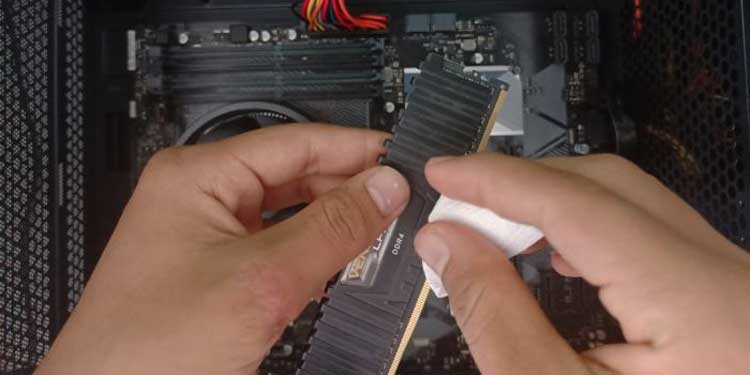Like any component in a computer system, RAM can accumulate dust and dirt over time which can cause it to overheat and malfunction. A dirty RAM can cause problems in the system ranging from clogged up ports; making them unusable to even causing short circuits. A good way to maintain the overall health of your device is to clean the components at least once every few months. You can use compressed air to remove dust and debris. For more thorough cleaning, electronics-safe solvent like IPA (isopropyl alcohol) is recommended. Here, we’ll show you how to remove the RAM safely from your device and then clean it afterward.
How to Remove the RAM?
Depending on the type of device you have, the RAM is different in a desktop and a laptop. First, we’ll show you how to properly remove the RAM from each type of system.
For Desktop
For desktop devices, the RAM rests in the DIMM (Dual In-line Memory Module) slot which is soldered to the motherboard. To clean the RAM, first you’ll need to remove it from the computer chassis.
For Laptops
Laptops use a smaller type of RAM called SO-DIMM (Small Outline Dual In-line Memory Module). These are more compact versions of the DIMM RAMs typically found in desktops.
Methods To Clean the RAM
Cleaning the RAM is a fairly easy and straightforward task. The process requires some tools to access the internal components of your device and some common chemicals. After successful removal, use the following methods to thoroughly clean the RAM
Compressed Air
Compressed air or electric dusters provide a non-abrasive method to clean the delicate components of the RAM. This is the safest method to remove any dust particles and loose debris from the RAM. To clean with compressed airUsing compressed air is the most safest and efficient way of cleaning the RAM. If you cannot procure compressed air, follow on to steps below.
Contact Solvents
If compressed air does not work, solvents like isopropyl 90% or ethanol can be used to clean any caked-in dirt, light corrosion or gummy substances. Make sure that the solvents are rated safe for electronic devices before proceeding. To clean the RAM
Eraser
You can also use a soft pencil eraser to remove stubborn dirt and stains from the RAM modules. If you’re planning to clean using this method, make sure that the eraser is clean and does not have any stains.Conductive materials like Pencil lead (graphite) and non-conductive materials in the eraser can damage the RAM or hamper them reducing its functionality. To clean the RAM modulesAfter cleaning the RAM, proceed to clean their slots as they may also have dirt and dust accumulated in them. The dirt is more likely to settle on the slots than the RAM sticks.
Methods to Clean the RAM Slot
The RAM slot technically called the DIMM (on most desktops) and SO-DIMM (in laptops) are soldered to the motherboard. These parts, can over time also accumulate dirt and other debris. This greatly reduces their functionality and causes unwanted problems in the system. To safely clean the RAM slots, After cleaning the RAM and their respective slots, re-insert the RAM back to the slots. Firstly align the RAM stick and press it gently until you hear an audible click. Adjust as necessary and make sure they are secure. Be mindful of the placement and orientation of the RAM in their respective slots as they are keyed and only fit when placed correctly.
Things to Avoid
Never pour alcohol or any cleaning solvent in the RAM directly.Make sure the components are not hot and are at least room temperature before cleaning them with solvents.Never directly blow from your mouth. This may cause static electricity to build up and moisture from the mouth to corrode the contacts.Using abrasive methods and rubbing aggressively with cloth or brushes can dislodge the contacts or damage the delicate electrical traces which may result in loss of functionality.Never use corrosive cleaners as they may produce hazardous fumes and damage the components of your RAM.





